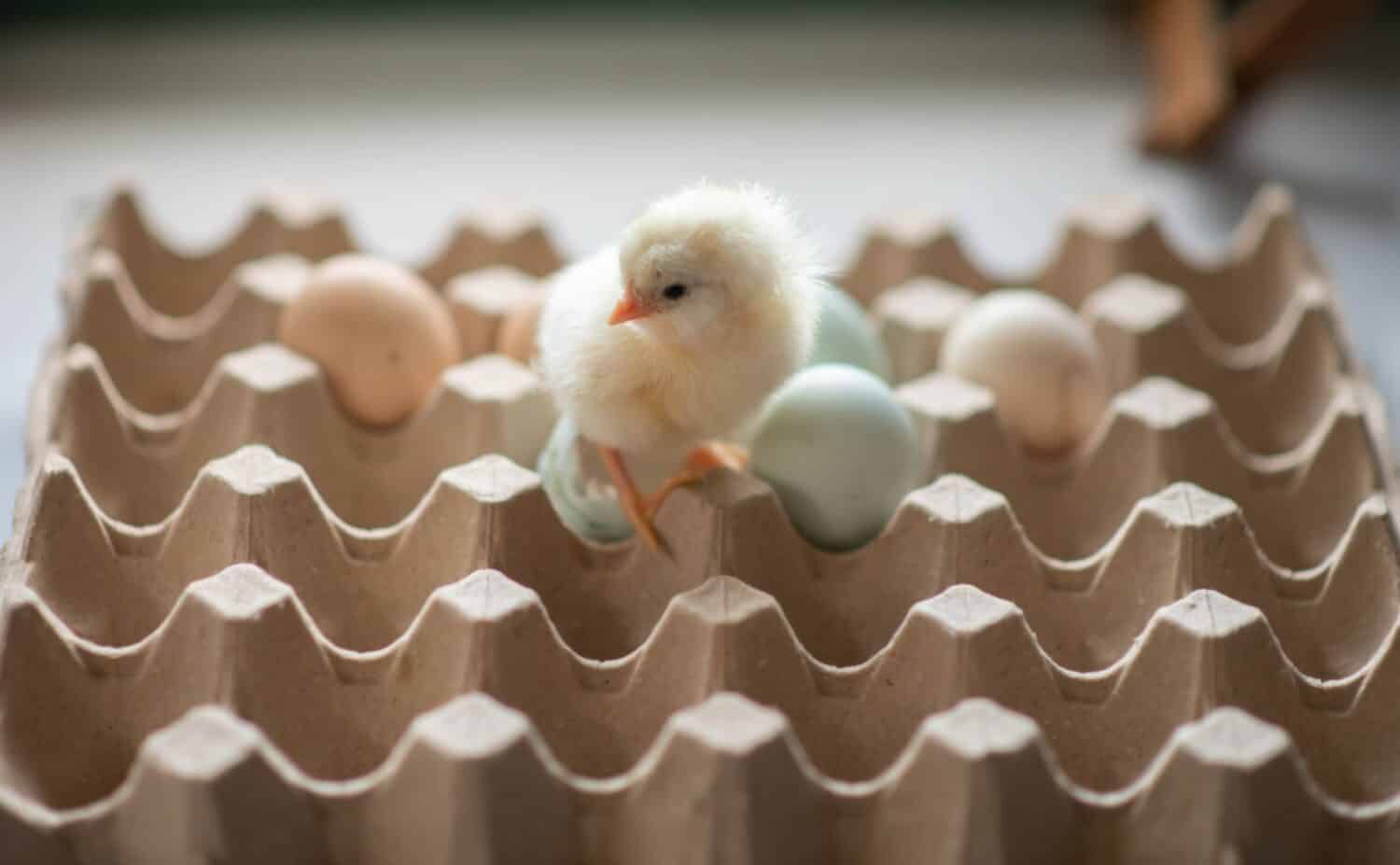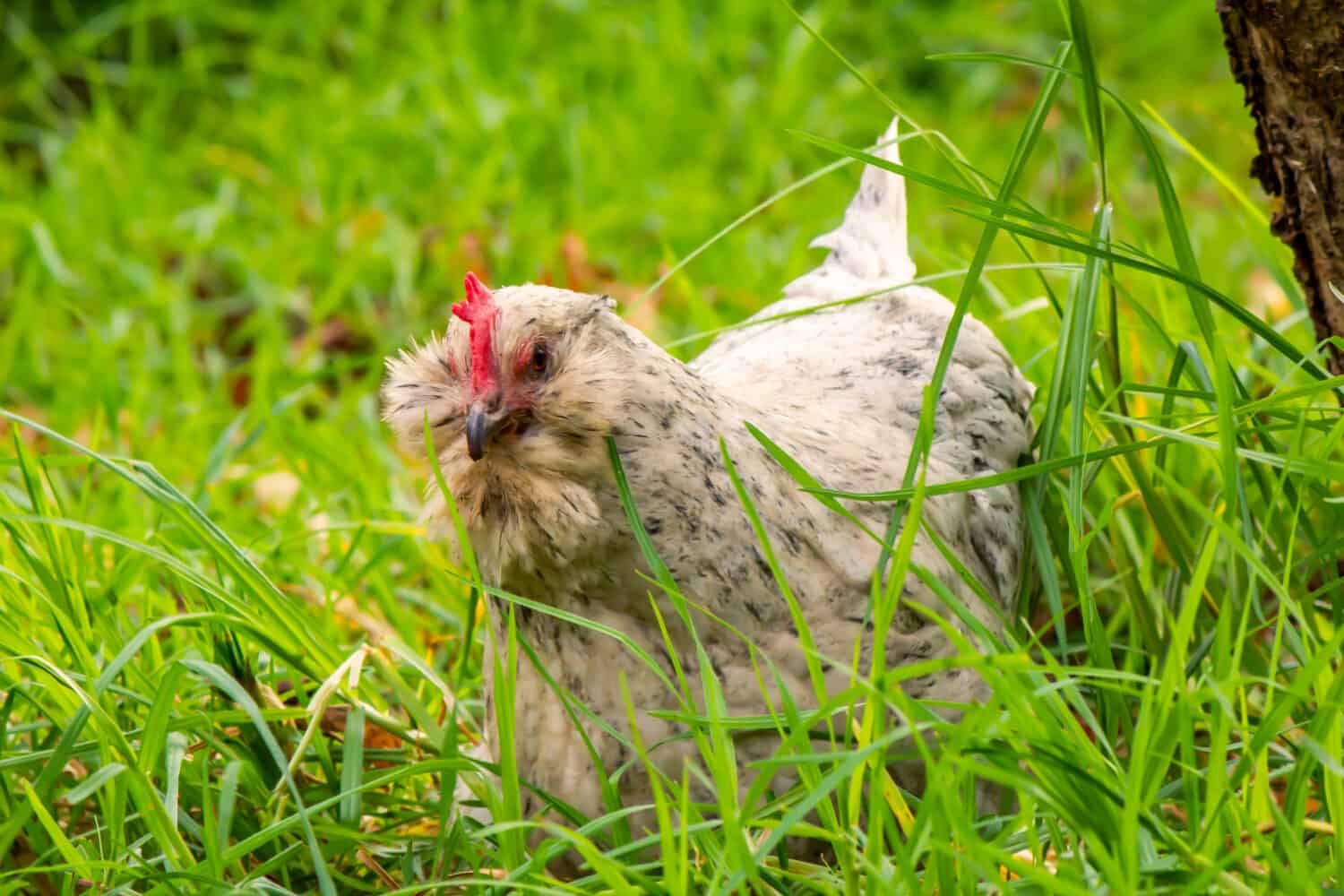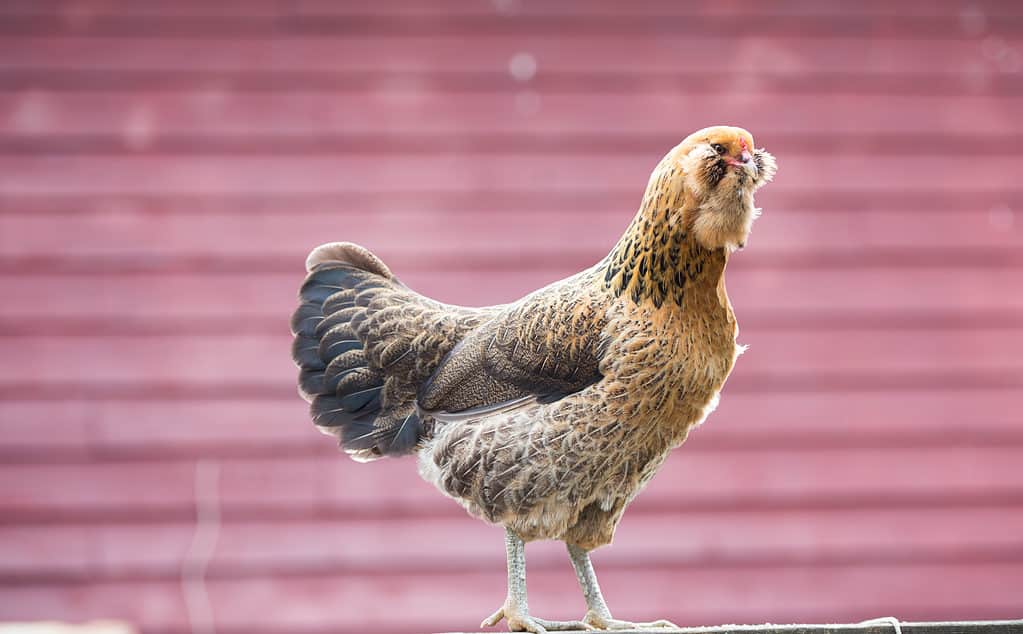Have you started looking at possibly buying a chicken (or many)? If so, the number of available breeds may feel overwhelming. That is why we have pulled together a guide on one of the most popular chickens, the Ameraucana. This breed originated in the United States and was bred from the South American Araucana chicken in 1970. This highly sought-after breed is known for its unique appearance and exceptional egg-laying capabilities. Ameraucanas were bred to retain the desirable blue egg-laying trait while avoiding some of the known pitfalls that come with Araucana chickens. The American Poultry Association entered this breed into the Standard of Perfection in 1984.
So, let’s dive in to learn more about the Ameraucana chicken.

Even the youngest Ameraucana chickens have distinctive coloring. They come in eight unique colors and are also available in mixed colors from certain breeders.
©Littlekidmoment/Shutterstock.com
What Does the Ameraucana Chicken Look Like?
Ameraucanas are medium-sized chickens with well-built, compact bodies. Males typically weigh between 6.5 to 7.5 pounds (2.9 to 3.4 kg), while females weigh slightly less, ranging from 5.5 to 6.5 pounds (2.5 to 2.9 kg). They have a proud, upright posture, broad chests, and sturdy, short legs.
What sets Ameraucanas apart from other breeds is their unique feathering. They have both beards and muffs, which blend into each other. Additionally, they have a red pea comb and may (or may not) have wattles.
The American Poultry Association (APA) recognizes eight distinct Ameraucanas colorings. These are black, blue, blue wheaten, wheaten, brown, red, buff, silver, and white. Each color variation has specific standards and breed characteristics. However, it is possible to find these birds with mixed coloring. You will just need to do your research on breeders.

Ameraucana chickens have a distinctive, hawk-like appearance that helps deter predators.
©Nebula photographies/Shutterstock.com
What Is the Life Span of Ameraucana Chickens?
Ameraucanas typically take around 5 to 10 months to reach maturity. However, growth rates may vary depending on genetics and nutritional factors. Provide your chickens with proper nutrition and a well-balanced diet to support their growth and development.
Ameraucana hens typically start producing eggs at approximately 5 to 6 months of age. But be aware that some hens may take up that 10-month mark!
Once your chickens have reached maturity, you will be able to keep them around for quite some time. This breed lives approximately 7 to 8 years. Their long life is another reason for their popularity since it means egg production should continue undisturbed for quite some time.
What Is the Temperament of Ameraucana Chickens?
Ameraucanas are renowned for their docile and friendly nature. So they are an excellent choice for families and households with children. They have a calm temperament and adapt well to various environments. These intelligent and curious birds are relatively easy to handle. Ameraucanas typically coexist peacefully with other chicken breeds, which makes them suitable for mixed flocks. Make sure to follow proper socialization practices and give them plenty of space.
Additionally, they are relatively active birds. That means they need plenty of space to roam. As long as the area you provide them offers enough room to explore, they will remain docile. But if they feel cooped up at all, you may run into issues.

Ameraucana chickens are extremely docile and family friendly, as long as they have enough space to explore and can roam freely from time to time.
©Vampyre Zen/Shutterstock.com
Do Ameraucana Chickens Have Health Issues?
Ameraucanas are generally robust and resilient. They were specifically bred that way. However, they may be susceptible to certain conditions. One condition to watch for is a cross beak, where the two sides of the beak become misaligned. This health concern makes the chickens more high-maintenance since they will need extra help eating and drinking.
Also, due to their muff and beard, you will want to check your flock regularly for mites and lice.

Ameraucana chickens have far fewer health issues than many other chicken breeds.
©Vampyre Zen/Shutterstock.com
Caring for Ameraucana Chickens
Ameraucanas have similar feeding requirements as other chicken breeds. They thrive on a balanced diet of high-quality feed, fresh fruits, vegetables, and occasional treats like mealworms or scratch grains. The quantity will depend on the bird’s size and activity level. On average, a mature Ameraucana chicken consumes around 1/4 to 1/3 pounds (115 to 150 grams) of feed per day.
However, during molting season, you will want to ensure your chickens get more protein. Aim for a 20% protein boost to keep them healthy and thriving. A good way to hit that number is to allow them to forage. They love foraging and should ideally get the opportunity to every other day. When you allow them to forage, they will have full control over their protein intake, so you don’t have to worry as much about it.
Their coop should offer protection from predators, good ventilation, and sufficient space for the birds to move around. The first goal isn’t as important with Ameraucanas as with other chickens. They are incredibly predator savvy. As long as you can accomplish the rest, they will be in good shape.
As medium-sized chickens, Ameraucanas typically require a minimum of 4 square feet (0.37 square meters) of coop space, with an additional 8 to 10 square feet (0.74 to 0.93 square meters) of outdoor space for optimal well-being. Since Ameraucanas are extremely active birds, the more space, the better. But if you can’t devote so much space to a coop, don’t worry. Just be sure to get them adequate free-range time instead.
Ameraucana Eggs
Ameraucana chickens lay medium to large-sized eggs. But keep in mind there will be variations with individual hens. On average, their eggs weigh around 2 to 2.5 ounces (56 to 70 grams). Almost all the eggs are blue in hue. That is a result of that selective breeding in the middle 20th century. That said, occasionally, eggs come out in an off-color. Typically that is nothing to worry about.
However, it’s important to note that the shell color does not affect the nutritional content or taste of the eggs. While the blue or green shade is quite visually captivating, the nutritional value and flavor remain consistent with eggs from other breeds.
Pros and Cons of Owning Ameraucana Chickens
Ameraucanas have several advantages that make them highly desirable. Their distinctive appearance, with fluffy plumage, beards, and muffs, adds a touch of elegance and charm to any flock. But the best part is their blue eggs, a fun and unique addition to any kitchen.
Their docile and friendly nature makes them an excellent choice for families, particularly those with children. Ameraucanas are generally easy to handle and adapt well to different environments. They are also consistent layers. So you will get a steady supply of eggs throughout the year.
This particular breed is also highly cold-tolerant, making it the ideal selection for colder environments. And, even better, Ameraucanas serve a dual purpose. You can raise them to be egg layers or as meat birds. That may make the decision a little easier.
However, it’s important to note that Ameraucanas may not be the most efficient egg producers compared to some breeds specifically bred for high egg production. They only lay about 3-4 eggs each week during the season and far fewer off-season. Other chickens may be more suitable if your primary goal is to maximize egg yield. Finally, like any chicken breed, Ameraucanas require proper care and attention to maintain their health and well-being.

Ameraucana chickens have a distinctive appearance. But they are most highly prized for their bright blue eggs.
©Anna Hoychuk/Shutterstock.com
Thank you for reading! Have some feedback for us? Contact the AZ Animals editorial team.







